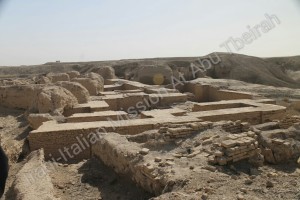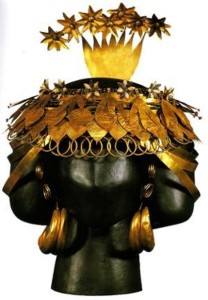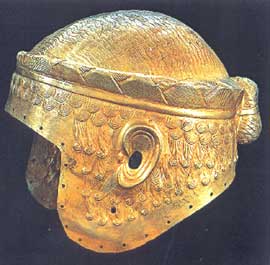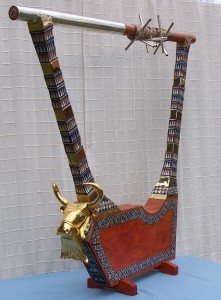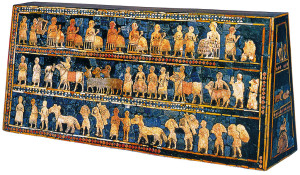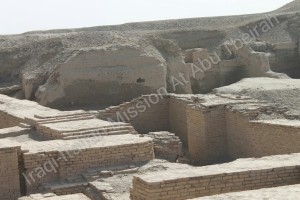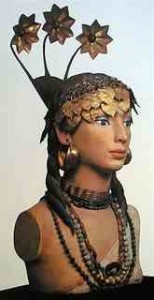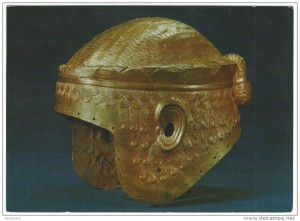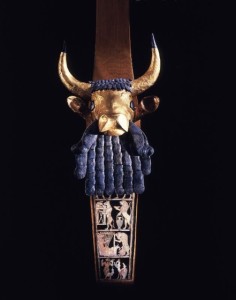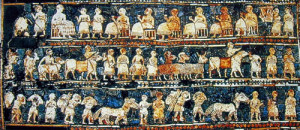THE GRAVES
The first excavations of C. Leonard Woolley at Ur (Iraq) in 1922 lasted twelve seasons with hundreds of workers, until the Great Depression stopped the funds in 1934. The focus was the royal cemetery, whose graves were filled with fine Dynastic Period artifacts. Inside the cemetery have been found 2000 common graves that consist in the rectangular pits, where the corpse lay on its side, wrapped in a mat or in a closed coffin, surrounded by offerings and various personal items; and 16 graves with rich set as those of Meskalamdug and Puabi.
These differ from those common since they are made of stone and brick tombs, real underground of one or more rooms. Alongside the rulers were in fact killed the characters of the following, courtiers and warriors, squires with their bullock carts and slaves of both sexes. Practice is not known elsewhere in southern Mesopotamia, nor described in the texts. The tombs of Meskallamdug and Puabi returned beautiful harps adorned with inlaid panels, gold crockery and gold jewelry in large numbers of very fine workmanship.
THE GOLDEN HARP
The cemetery offers objects of exceptional beauty and uniqueness as the lyre and the so-called gold standard of Ur. Here, were found four lyres, two of them were part of the funeral equipment of Queen Puabi. The golden harp or harp bull is considered one of the most beautiful, and it was preserved in the Museum of Iraq until 2003, when it was destroyed. A replication was reconstructed thanks to international aid and cooperation of authorities. The harp was composed of mixed wood and inlaid with mother of pearl, carnelian, lapis lazuli and gold.
STANDARD OF UR
In the tomb PG 779, one of the largest of the necropolis associated with Ur-Pabilsag it was found a standard. It is a wood panel covered with bitumen and inlaid with lapis lazuli inserts, reddish limestone and sea shells from the Indian coast. On both sides of the figuration spread over three registers, separated by decorative trims. On the one hand have the so-called face of peace with the representation of a banquet and a procession to the king in the first register, while in subsequent courtiers, farmers, traders and craftsmen. The other side is called the war because are depicted soldiers. The king is recognizable by the bigger with which is represented respect to his subjects. Woolley suggested that the object was stuck on a pole and was carried in procession as a standard, opinion is not accepted. Other researchers thought a sounding board for a musical instrument. In any case, its function is still unclear.
LE TOMBE
I primi scavi di C. Leonard Woolley a Ur (Iraq) nel 1922 durarono dodici stagioni con centinaia di lavoratori, fino a quando la grande Depressione bloccò i fondi nel 1934. Il punto centrale era il cimitero reale, le cui tombe erano piene di raffinati manufatti del periodo protodinastico. All’interno del cimitero sono state ritrovate 2000 tombe comuni costituite da fosse rettangolari, in cui il cadavere giaceva su un fianco, avvolto in una stuoia o chiuso in un sarcofago, circondato da offerte e da vari oggetti personali; e 16 con ricco corredo come quelle di Meskalamdug e di Puabi.
Secondo gli studiosi quest’ultime appartenevano ad una famiglia reale e dopo il decesso del re e della regina i membri della corte furono messi a morte durante sacrifici rituali. Le 16 tombe si differenziano da quelle comuni dal momento che sono costituite da sepolcri in pietra e mattoni, veri e propri ipogei di una o più camere. Accanto ai sovrani erano infatti uccisi i personaggi del seguito, cortigiani e guerrieri, scudieri con i loro carri trainati da buoi e schiavi di ambo i sessi. Pratica non conosciuta altrove nel sud della mesopotamia, ne descritta nei testi.Le tombe di Meskallamdug e Puabi hanno restituito bellissime arpe adorne di pannelli intarsiati, vasellame d’oro e gioielli in gran numero, di fattura assai raffinata.
L’ARPA
Il cimitero offre oggetti di particolare bellezza e unicità come la lira d’oro e il cosiddetto stendardo di Ur. Qui, sono state trovate quattro lire, due di loro facevano parte del corredo funebre della regina Puabi. L’arpa d’oro o arpa del toro è considerata una delle più belle, ed era conservata nel Museo iracheno fino al 2003, quando è stata distrutta. Una replica è stata ricostruita grazie agli aiuti internazionali e la collaborazione di enti. L’arpa era composta da legno misto e intarsiato con madreperla, corniola, lapislazzuli ed oro.
STENDARDO DI UR
Nella tomba PG 779, una delle maggiori della necropoli, associata ad Ur-Pabilsag è stato ritrovato uno stendardo. È un pannello ligneo ricoperto di bitume e intarsito con inserti in lapislazzuli, pietra calcarea rossastra e conchiglie marine provenienti dalle coste indiane. Su entrambe le facce la figurazione si sviluppa su tre registri, separati da fasce ornamentali. Da un lato abbiamo la cosiddetta faccia della pace con la raffigurazione di un banchetto e di una processione alla presenza del re nel primo registro, mentre in quelli successivi cortigiani, contadini, commercianti e artigiani. L’altro lato è detto della guerra poiché sono raffigurati soldati. Il re è riconoscibile per le maggiori dimensioni con cui viene rappresentato rispetto ai suoi sudditi. Woolley ipotizzò che l’oggetto fosse infilato su un palo e fosse portato in processione come uno stendardo, opinione non accettata. Altri studiosi pensarono ad una cassa di risonanza per uno strumento musicale. In ogni caso la sua funzione non è ancora chiara.
